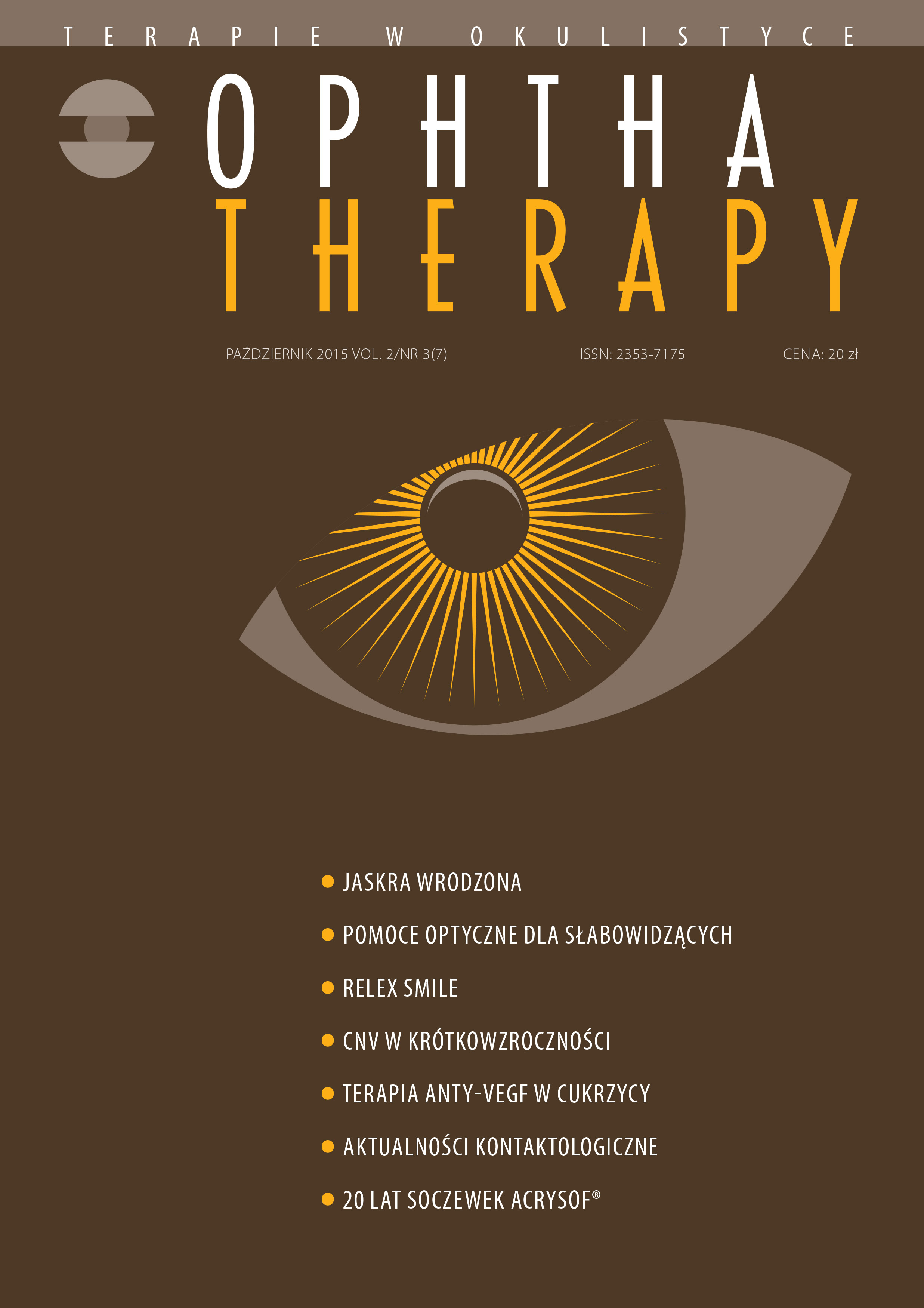Choroidal neovascularization in degenerative myopia – efficacy of ranibizumab therapy (case report)
Main Article Content
Abstract
A case report of myopic choroidal neovascularization in 42-year old man treated with ranibizumab.
Downloads
Download data is not yet available.
Article Details
How to Cite
1.
Fulbiszewska J, Fluder E, Jeziorny R. Choroidal neovascularization in degenerative myopia – efficacy of ranibizumab therapy (case report). Ophthatherapy [Internet]. 2015Sep.30 [cited 2025Aug.2];2(3):197-01. Available from: https://journalsmededu.pl/index.php/ophthatherapy/article/view/642
Issue
Section
Articles

This work is licensed under a Creative Commons Attribution-NonCommercial-NoDerivatives 4.0 International License.
Copyright: © Medical Education sp. z o.o. License allowing third parties to copy and redistribute the material in any medium or format and to remix, transform, and build upon the material, provided the original work is properly cited and states its license.
Address reprint requests to: Medical Education, Marcin Kuźma (marcin.kuzma@mededu.pl)
References
1. Kański J. Okulistyka kliniczna. Elsevier Urban and Partner, Wrocław 2011; 623-5.
2. Neelam K, Cheung CM, Ohno-Matsui K et al. Choroidal neovascularization in pathological myopia. Prog Retin Eye Res. 2012; 31(5): 495-525.
3. Wong TY, Ferreira A, Hughes R et al. Epidemiology and disease burden of pathologic myopia and myopic choroidal neovascularization: an evidence-based systematic review. Am J Ophthalmol. 2014; 157(1): 9-25.
4. Wakabayashi T, Ikuno Y. Choroidal filling delay in choroidal neovascularisation due to pathological myopia. Br J Ophthalmol. 2010; 94(5): 611-5.
5. Leveziel N, Yu Y, Reynolds R et al. Genetic factors for choroidal neovascularization associated with high myopia. Invest Ophthalmol Vis Sci. 2012; 53(8): 5004-9.
6. Akagi-Kurashige Y, Kumagai K, Yamashiro K et al. Vascular endothelial growth factor gene polymorphisms and choroidal neovascularization in highly myopic eyes. Invest Ophthalmol Vis Sci. 2012; 53(4): 2349-53.
7. Miyake M, Yamashiro K, Nakanishi H et al. Evaluation of pigment epithelium-derived factor and complement factor I polymorphisms as a cause of choroidal neovascularization in highly myopic eyes. Invest Ophthalmol Vis Sci. 2013; 54(6): 4208-12.
8. Blinder KJ, Blumenkranz MS, Bressler NM et al. Verteporfin therapy of subfoveal choroidal neovascularization in pathologic myopia: 2-year results of a randomized clinical trial – VIP report no. 3. Ophthalmology. 2003; 110: 667-73.
9. Montero JA, Ruiz-Moreno JM. Combined photodynamic therapy and intravitreal triamcinolone injection for the treatment of choroidal neovascularisation secondary to pathological myopia: a pilot study. Br J Ophthalmol. 2007; 91: 131-3.
10. Secretan M, Kuhn D, Soubrane G et al. Long term visual outcome of choroidal neovascularisation in pathologic myopia: natural history and laser treatment. Eur J Ophthalmol. 1997; 7: 307-16.
11. Hamelin N, Glacet-Bernard A, Brindeau C et al. Surgical treatment of subfoveal neovascularisation in myopia: macular translocation vs surgical removal. Am J Ophthalmol. 2002; 133: 530-6.
12. Ruiz-Moreno JM, de la Vega C. Surgical removal of subfoveal choroidal neovascularisation in highly myopic patients. Br J Ophthalmol. 2001; 85: 1041-3.
13. Mateo C, Moreno J, Rosales G et al. Two-year results of macular translocation with sclera infolding in myopic choroidal neovascularisation. Semin Ophthalmol. 2004; 19: 29-42.
14. Charakterystyka produktu leczniczego – leku Lucentis – aneks I., Novartis Europharm Limited.
2. Neelam K, Cheung CM, Ohno-Matsui K et al. Choroidal neovascularization in pathological myopia. Prog Retin Eye Res. 2012; 31(5): 495-525.
3. Wong TY, Ferreira A, Hughes R et al. Epidemiology and disease burden of pathologic myopia and myopic choroidal neovascularization: an evidence-based systematic review. Am J Ophthalmol. 2014; 157(1): 9-25.
4. Wakabayashi T, Ikuno Y. Choroidal filling delay in choroidal neovascularisation due to pathological myopia. Br J Ophthalmol. 2010; 94(5): 611-5.
5. Leveziel N, Yu Y, Reynolds R et al. Genetic factors for choroidal neovascularization associated with high myopia. Invest Ophthalmol Vis Sci. 2012; 53(8): 5004-9.
6. Akagi-Kurashige Y, Kumagai K, Yamashiro K et al. Vascular endothelial growth factor gene polymorphisms and choroidal neovascularization in highly myopic eyes. Invest Ophthalmol Vis Sci. 2012; 53(4): 2349-53.
7. Miyake M, Yamashiro K, Nakanishi H et al. Evaluation of pigment epithelium-derived factor and complement factor I polymorphisms as a cause of choroidal neovascularization in highly myopic eyes. Invest Ophthalmol Vis Sci. 2013; 54(6): 4208-12.
8. Blinder KJ, Blumenkranz MS, Bressler NM et al. Verteporfin therapy of subfoveal choroidal neovascularization in pathologic myopia: 2-year results of a randomized clinical trial – VIP report no. 3. Ophthalmology. 2003; 110: 667-73.
9. Montero JA, Ruiz-Moreno JM. Combined photodynamic therapy and intravitreal triamcinolone injection for the treatment of choroidal neovascularisation secondary to pathological myopia: a pilot study. Br J Ophthalmol. 2007; 91: 131-3.
10. Secretan M, Kuhn D, Soubrane G et al. Long term visual outcome of choroidal neovascularisation in pathologic myopia: natural history and laser treatment. Eur J Ophthalmol. 1997; 7: 307-16.
11. Hamelin N, Glacet-Bernard A, Brindeau C et al. Surgical treatment of subfoveal neovascularisation in myopia: macular translocation vs surgical removal. Am J Ophthalmol. 2002; 133: 530-6.
12. Ruiz-Moreno JM, de la Vega C. Surgical removal of subfoveal choroidal neovascularisation in highly myopic patients. Br J Ophthalmol. 2001; 85: 1041-3.
13. Mateo C, Moreno J, Rosales G et al. Two-year results of macular translocation with sclera infolding in myopic choroidal neovascularisation. Semin Ophthalmol. 2004; 19: 29-42.
14. Charakterystyka produktu leczniczego – leku Lucentis – aneks I., Novartis Europharm Limited.

